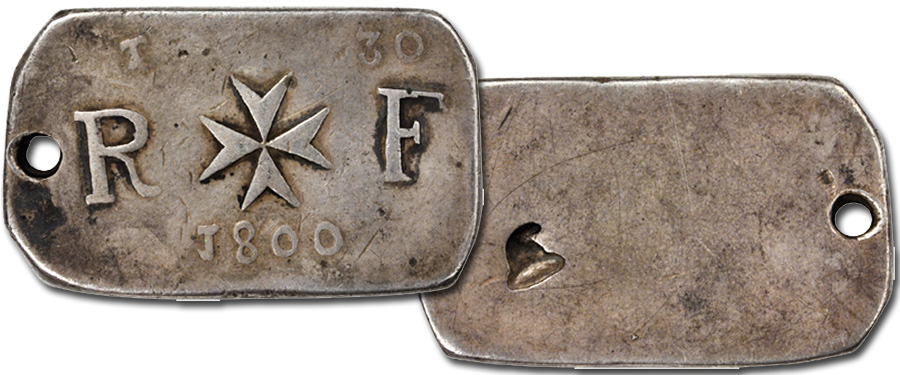
With the Stack’s Bowers and Ponterio January New York International Auction just a week away, there is just one final preview. Sometimes we save the best for last, and this piece is certainly among the highlights of this auction. Historically significant, extremely rare and very important, this coin brings together a fantastic story with substantial rarity to form a true numismatic treasure.
On June 9, 1798, while on his way to Egypt, Napoleon with his expeditionary force of over 30,000 men arrived at Malta off the coast of the heavily fortified port capital of Valletta. Upon reaching the island he sought fresh water and other provisions, demanding that his entire force be allowed to land. Trying to stay neutral Grand Master Ferdinand von Hompesch zu Bolheim refused Napoleon’s demand and insisted that only four ships could land at a time. Once his demands were refused Napoleon ordered his fleet to bombard the city. On June 11 he landed an assault force of several thousand men at seven strategic locations around the island. Once the city of Medina fell to the French the native militia of about 2,000 men retreated to the capital. Though Valletta had the resources to hold out for a prolonged period Napoleon negotiated surrender with Hompesch. On June 19, after the conquest of the island, Napoleon departed for Egypt and left General Claude-Henri Belgrand de Vaubois in charge with 4,000 men. Learning of the French invasion of Malta while in Sicily, British Rear-Admiral Sir Horatio Nelson attempted to intercept the French Fleet but overshot them under cover of night on June 22 without discovering their presence. On June 28 he arrived off Alexandria ahead of Napoleon and with the absence of the French, Nelson believed that they must have a different objective. Nelson then divided his forces sending a squadron to blockade Malta with the remainder moving northward to investigate, missing Napoleon by 24 hours. Once reaching Egypt the unopposed Napoleon ordered his fleet to anchor in Aboukir Bay and turned his forces inland. On August 1 Nelson returned to the Egyptian coast, found the French fleet anchored and immediately began attacking. Taking only moderate damage Nelson incapacitated the French fleet, capturing nine ships and destroying two including their flagship the Orient.
During the occupation the native Maltese rebelled against the French and on September 2 drove them to the capital. On December 29, 1798, the British and the Russians signed a convention in St. Petersburg stating that upon the surrender of the French, Malta would be supplied a garrison consisting of British, Naples and Russian forces. After a brief stint off the island Russian admiral Fyodor Fyodorovich Ushakov was ordered to join the Russo-Turkish forces besieging the island of Corfu. In early 1799 the French were able to get several ships through the blockade to replenish the dwindling resources. Several requests were sent to the Russian admiral for his return to Malta, but were ignored as his fleet was in severe disrepair and he was awaiting orders from Czar Paul I. While corresponding with Nelson, Ushakov told the British Rear-admiral that with his ships and 2,000 men he would depart from Naples on November 17, but never did. In fact Ushakov had planned on returning to the Black Sea instead of Malta, but ended up staying in Corfu until July 1800.
In the early summer of 1800 the British blockade continued to prevent French forces from resupplying the besieged Valletta. Nelson had sent several requests for the surrender of the city to which the French took great insult. By the end of the siege, more than 100 people were dying per day due to the lack of sufficient provisions. On September 4 Vaubois dispatched an envoy to the British to discuss and sign the terms of surrender with Vaubois and Villeneuve. After the surrender of the French forces Malta became a British protectorate until it obtained independence in 1964.
This rectangular ingot (22.10 by 36.03 millimeters, weighing 29.02 grams), created by French mint master Joseph Lebrun, features a large Maltese cross at the center immediately identifying this piece with the island nation. It is flanked by large letters: “R – F” signifying the “Republique Francais.” The denomination is noted in smaller characters above “T 30” for 30 Tari with the date – 1800 – below the cross. The reverse is blank save for the Phrygian cap mintmark at left. Pierced at nine o’clock, this ingot also displays nice grey toning. The siege ingots of Malta as issued by the French in 1799-1800 mark the last coins actually struck in Malta, all of which are of the utmost rarity. This incredible piece of history is sure to draw spirited bidding and is certainly a piece to watch!
Look for this and other world numismatic rarities in our upcoming January New York International Auction. For details please refer to the Events Calendar link at www.StacksBowers.com. Though our Stack’s Bowers January New York International Auction is no longer open for consignments, we are accepting consignments of world and ancient coins for our August 2016 ANA Auction as well as Chinese and other Asian coins and currency for our April 2016 Hong Kong Showcase Auction. Time is running short, so if you are interested in consigning your coins and paper currency (whether a whole collection or a single rarity) be sure to contact one of our consignment directors.





